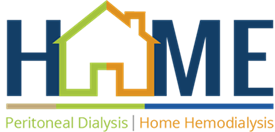Home Dialysis Quality Improvement Activity (QIA)
Home Dialysis Quality Improvement Activity (QIA)

2025-26 NATIONAL GOALS:
- Increase the number of incident ESRD patients using a home modality for dialysis by 30%
- Increase the number of prevalent ESRD patients moving to a home modality by 18%
Interventions
Patient Engagement Interventions
Infections
Peer Mentoring
- Pair patients who’ve gotten CVC removed and replaced with permanent access with patients who are resisting.
- Have patients who’ve experienced infection/sepsis share what that was like. This can be done as a story in educational handouts. You can also create a bulletin board where patients share ideas on how to avoid infections (tips, tricks), including getting vaccinated!
Life Planning
- SMART Goals Worksheet
- IDT should be familiar with this framework to assist patients in identifying self-directed goals for the care plan that may lead to home transitions.
- Tie infection into QOL goals in care plans.
- Examples:
- X wants to stay on PD as long as she can, as healthily as she can. She wants to avoid peritonitis and plans to improve her handwashing techniques.
- “I (Mr. X) do not want to get gangrene and lose my foot. I will follow through with my referral and try to follow recommendations. I will seek assistance from the dialysis team if I have questions or problems.”
- Examples:
QAPI
- Include patients in QAPI to discuss hospitalization (infection related) measures.
- Remember, patients do not have to be physically present to participate. They can attend virtually. They also do not have to be present for the entire meeting. It is okay to focus on just 2 or 3 measures that are important to the facility or the patient.
- Talk about where the facility is currently with the measure and what the goal is. Share the proposed intervention(s) or brainstorm. Encourage patients to provide feedback on barriers, patient motivators and interventions.
-
Create bulletin board. Use the 5 Easy Steps Flyer for guidance. Provide data that shows comparison in number of deaths/hospitalizations in previous year(s) between patients with and without infections.
Missed/shortened treatments
Peer Mentoring
- Help patients make friends.
- Utilize NKF Peers for support and education. Encourage patients to become trained mentors or to be connected with one.
- Share Peers Flyer (English and Spanish)
- NKF Peers link: https://www.kidney.org/treatment-support/peers
- Market your trained mentors
- Poster template- under development
- Create motivational games (link to https://beacon.by/quality-insights/gamespresentation-slide-deck-only)
- Level playing field. Avoid your targeted patients feeling defeated before beginning by making sure they have a good chance of succeeding. For example, rather than setting the goal for 100% attendance, everyone gets a ticket for every treatment they attend.
- Create competition with teams.
- Keep it fresh! Doing the same thing over and over, will lose it’s flare. Change the game up every month.
- Ask patients what will motivate them (prizes). Examples of games and prizes are provided in the link above.
Life Planning
- Tie missed/shortened treatments into QOL goals in care plans.
- Examples:
- “I (Mr. X) need to be able to raise my children. I know I need dialysis to live. I will commit to increasing my attendance by coming to treatment at least twice a week.“
- X wants a transplant. She has been deactivated from the waitlist because she has been oversleeping in the mornings and her treatments are having to be shortened. She has decided to change shifts so that she can get to treatment on time and get her full prescribed time. This will get her activated again on the waitlist.
- Examples:
QAPI
- Include patients in QAPI to discuss hospitalization (missed/shorted treatment related) measures.
- Remember, patients do not have to be physically present to participate. They can attend virtually. They also do not have to be present for the entire meeting. It is okay to focus on just 2 or 3 measures that are important to the facility or the patient.
- Talk about where the facility is currently with the measure and what the goal is. Share the proposed intervention(s) or brainstorm. Encourage patients to provide feedback on barriers, patient motivators and interventions.
- Create an interactive bulletin board. Use the 5 Easy Steps Flyer for guidance. Provide data that shows comparison in number of deaths/hospitalizations in previous year(s) between adherent patients and those who skip/shorten treatment.
Linked Resources
Home Dialysis
Webinars
January 30, 2025
NKF Peers Program Webinar Recording:
Are You Struggling to Increase Your Home and Transplant Rates? NKF Peers Can Help
Facility Data Dashboard
Facility Dashboard Login – please contact the Network for username and password
Network 5 Contact
Elizabeth Nuschke, RD
Phone: (804) 320-0004 x2710
enuschke@qualityinsights.org
PDF Resources
If the resource library does not automatically load on the page below, you can access it directly.

